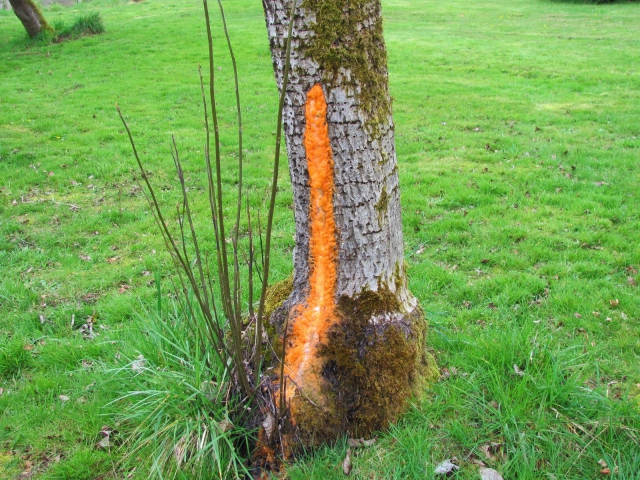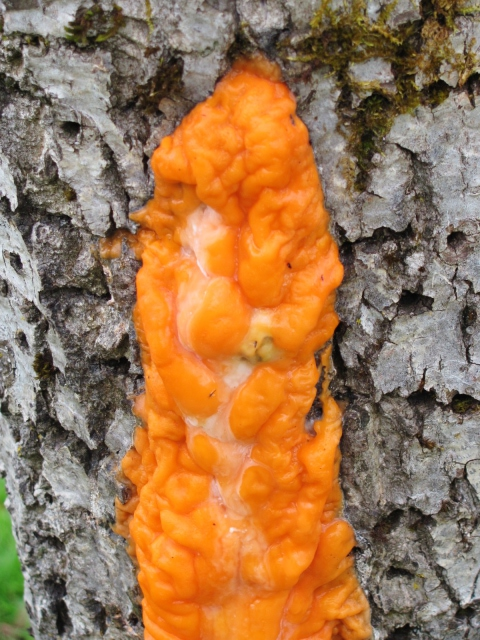QuestionQUESTION: My girl friend in Oregon has a some walnut trees (black, I think). One has a what appears to be a large streak of orange fungus or mold (It is jelly like). It extends from the bottom of the trunk about four or five feet up and is about three or four inches wide. We have not seen anything like it before. Do you have any idea what it might be and or what to do about it?
I have a photo of it if that would help.
ANSWER: Hi Dick,
A picture would help if you can provide one. Also, if you could give me a little bit of information about the tree (i.e. estimated age, location of tree on property, history, general health etc.) it would help me immensely. I definitely have some ideas about what it might be and what the cause could be, but at this point it抯 just conjecture.
Thanks
James
---------- FOLLOW-UP ----------
 orange fungus
orange fungus  orange fungus
orange fungus
QUESTION: The tree is one of three walnut tree in an orchard that also has a three apple trees and a plum tree, pear tree and a cherry tree but they are not crowded together. It is a mature tree probably thirty or more years old and still producing walnuts. It twenty to thirty yards from any structure or road,is not close to any structure or road. The 10 acre property has horses, turkeys, cats, peafowl, ground squirrels and chickens that wander around a large open space. it is located three miles from Scio, Oregon in the Willamette valley. My girl friend is into horses and does not spray or take care of the orchard except to mow. However, all the trees produce nuts and fruit. Neither of us have seen anything like this fungus before.
AnswerThanks for the great pictures. I've seen this fungus (or something very similar to it) while growing up in Oregon. I have lots of memories as a kid scraping this orange goo off of recently cut stumps and playing with it (or throwing it at someone).It looks very similar to a fungus called 揼olden jelly fungus?(Tremella mesenterica). The yellow slime is the fruiting bodies and is formed during wet periods. In the Pacific Northwest, it抯 found on a multitude of trees including: maple, poplar, or pine, but is most abundant on red alder. The fungi usually grow parasitically on other wood-rotting fungi that are already present.Essentially what抯 happening is the 搚ellow slime?is growing on another fungus that抯 in-turn feeding on decaying wood.
The 搚ellow slime?itself isn抰 really the problem but rather a 搒ign?or indicator that there抯 other forces at work also. There are likely areas of dead wood behind the bark which you can抰 see that are slowly decaying, as they do fungi that are saprophytic (wood rotting) will be present. Having rotten cavities in orchard trees is very common in and doesn抰 necessary have any bearing on the trees long term health. If however you begin to notice other signs and symptoms of decline, it might be necessary to start addressing some of the factors that may be stressing the tree.
For now though I wouldn抰 worry too much about the 搚ellow slime? What you抣l likely notice is as the spring progresses and the rain becomes infrequent the slime will dry up and disappear. It may return as subsequent rain events occur, but don抰 be alarmed. If the tree is budding out normally then you don抰 have to be concerned.
Thanks for the question.
James







